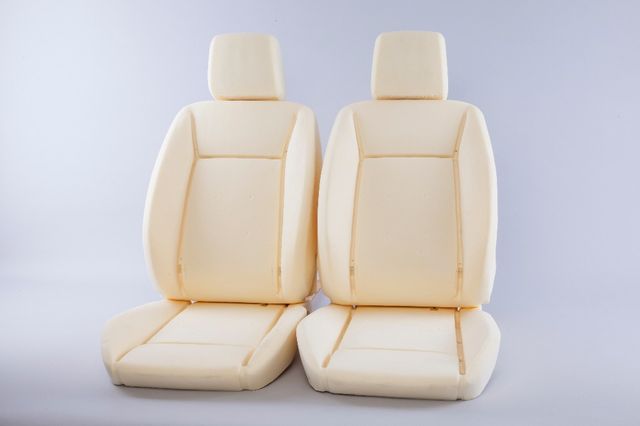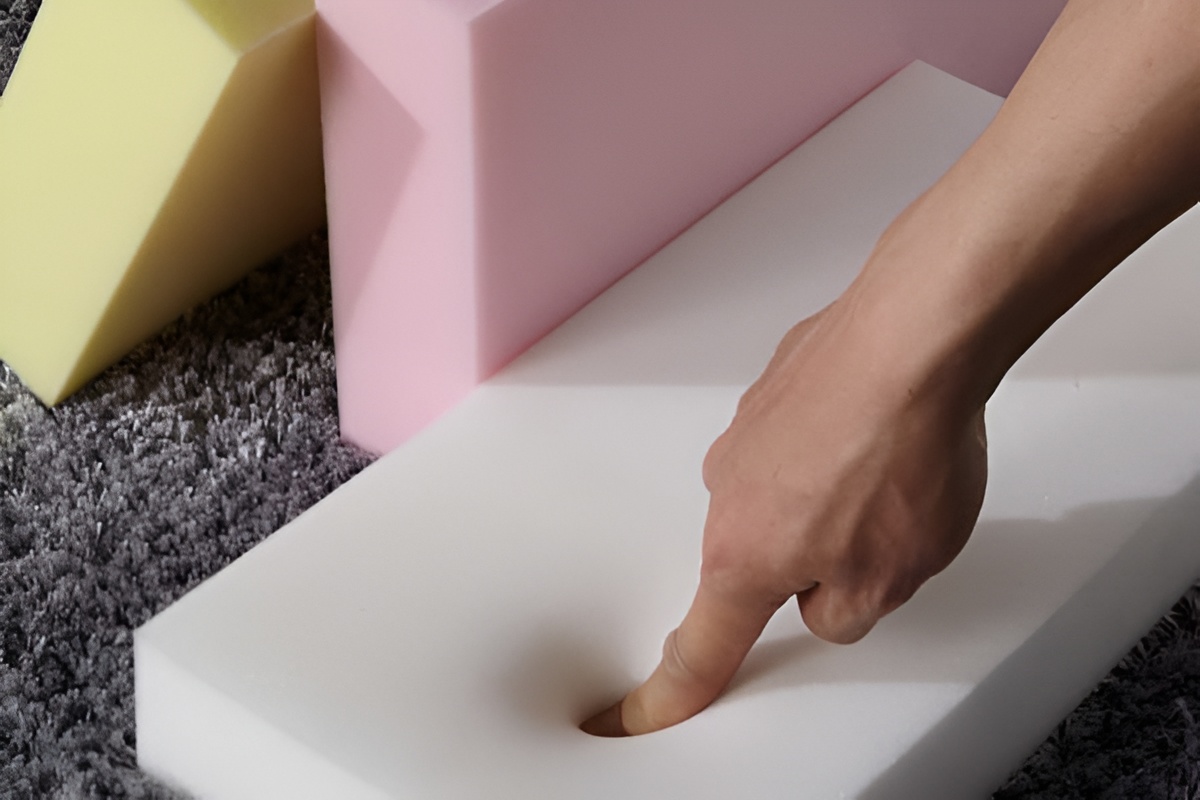Table of contents
No matter if it is a short trip or a long road travel, high-quality seat foam provides ergonomic support, reduces fatigue, and maintains its shape over time. Therefore, the right car seat foam not only improves the feel of passengers but also plays a major role in vehicle aesthetics, safety, and long-term wear resistance. In the following article, we will discuss different types of car seat foams and try to help you choose the best material for foam production.
Why car seat foam matters?
When you consider car comfort, there are different factors that contribute to a good feeling while driving. One of the most impactful items is the foam inside the seats. In fact, it is a critical, but often overlooked component.
A great car seat foam not only has suitable softness, it also should have ergonomic support, impact absorption, temperature control, and even long-term durability. In other words, the right foam has the ability to transform a simple seat into a memorable experience during drive. On the other hand, the wrong foam can lead to premature wear, discomfort, driver fatigue, and even back pain.
With today’s rising customer expectations and competitive markets, every detail is deeply important and car seat foam is no exception. Choosing the optimal foam type doesn’t just enhance comfort; it improves safety, extends product life, and reinforces brand reputation.
The history of car seat foam and its evolution
In the past, car seats were made of materials like cotton batting, horsehair, and metal springs. While these materials provided basic cushioning, they lacked the resilience and comfort that was required for long time use. The introduction of foam materials really changed car seat design, offering enhanced comfort and durability.
In the 1950s, polyurethane (PU) foam shown up as a polymer material that change everything in the automotive industry. Its lightweight nature, combined with excellent cushioning properties, made it an ideal choice for car seat manufacturers. Also, it has to be mentioned that over the decades, advancements in foam technology have led to the development of various foam types, each providing specific comfort and performance needs.
After sales service
For price inquiries and purchasing liquid polyurethane for polyurethane foam production, please contact Imen Polymer Chemie Company.
Types of car seat foam (Pros and Cons)
Modern car seats can be produced with different types of Polyurethane foam, so each has its own advantages and disadvantages. In the following we will discuss the most commonly used materials.
1. Cold cure polyurethane foam
Cold cure polyurethane foam is the most widely used material in automotive seating due to its cost-effectiveness, versatility, and excellent balance between comfort and structural support. The pros and cons are mentioned below.
Pros:
- Affordability: It is the most affordable option, offering a cost-effective solution. In other words, it has a great durability that’s why we call it cost-effective.
- Variety: Available in a wide range of densities and firmness levels (although high knowledge is needed, the formulation can be customized).
- Ease of maintenance: Lighter and easier to care for. It doesn’t need any precise care (it keeps its shape and support over time).
Cons:
- Long-term compression: In lower-density or poorly formulated foams, long term use may lead to compression set (the foam cannot fully recover its original shape) resulting in reduced support over time.
- Volatile organic compounds (VOCs): Some polyurethane foams may emit low levels of VOCs shortly after manufacturing. However, this issue can be minimized with proper formulation and the use of certified low-emission systems that comply with automotive and indoor air quality standards.
- Cost: While polyurethane foam offers excellent performance and customization options, high-quality formulations especially the ones with enhanced durability, fire resistance, or special additives can be more expensive than basic foam types. However, the investment pays off in terms of comfort, longevity, and customer satisfaction.
2. Memory Foam
Memory foam is known for its ability to conform to the shape of the body, providing excellent pressure relief and comfort. While not used in the core car seat foam itself, it’s a popular choice for car seat cushions and lumbar support pillows. Here’s the pros and cons:
Pros:
- Contouring: Memory foam contours to the body, offering personalized comfort and support.
- Pressure relief: It distributes weight evenly, reducing pressure points.
- Noiseless: Memory foam is quiet, ensuring no noise disturbance with movements.
Cons:
- Heat Retention: It can trap heat, which may lead to a warmer sitting experience.
- Off-Gassing: Newly manufactured memory foam can release a chemical odor, though it dissipates over time.
- Responsiveness: It takes time to return to its original shape, which can be a concern for those who prefer a bouncy feel.

3. Latex PU Foam
Latex PU foam/latex-like foam (we shortly call it latex foam) is made up of with polyurethane and is known for its elasticity (flexibility) and durability. It provides a unique combination of support and comfort, with a bouncy feel that some people prefer over the contouring feel of memory foam.
Pros:
- Longevity: Latex foam is highly durable and can last many years without losing its resilience.
- Comfort: It provides a comfortable balance of softness and support.
Cons:
- Higher Cost: Latex foam is generally more expensive than other foam types (it is a high tech and almost newly developed foam).
- Weight: It can be heavier, which may impact fuel efficiency in vehicles.
High-density vs. low-density foam: which lasts longer?
Foam density refers to how much material is packed into a given volume, usually measured in kilograms per cubic meter (kg/m³). Foam density plays a major role in defining the comfort, support, and durability of car seats. As a result, understanding the differences between high-density and low-density foam can help in selecting the appropriate material for specific automotive applications.
1. High-density foam
Foams with higher densities show greater support and durability. They maintain their shape over time, and provide consistent comfort and support. Their advantages and disadvantages can be categorized as follows:
Advantages:
- Durability: These foams are more resistant to wear and tear, ensuring a longer lifespan.
- Support: They provide firm support, reducing the risk of early sagging.
- Longevity: They maintain their structural integrity over time.
Disadvantages:
- Cost: Generally, they are more expensive than low-density foam (because of more material consumption).
- Weight: They are heavier, which may affect vehicle weight distribution.
2. Low-density foam
Low-density foams feel softer and more flexible, offering immediate comfort. However, they may not be able to keep their exact shape over time.
Advantages:
- Affordability: They are more affordable.
- Comfort: They provide a soft feel upon the first use.
Disadvantages:
- Durability: They are much more prone to sinking and deformation compared to high-density foams
- Support: They may not offer enough support for extended periods.
Which type of foam is better for your car?
The choice between different foam types depends on various factors, including:
• Vehicle Type: Luxury vehicles may prioritize comfort, and use modern foams like latex-like foam while commercial vehicles may focus on durability, and choose cold-cure (high resilience) polyurethane foam.
• Budget: Polyurethane foams are great options, but based on the type (latex, cold-cure, …) the cost is different.
• Climate Considerations: In warmer climates, breathable materials like latex foam may be preferable to reduce heat trapping.
Purchase of polyurethane foam raw materials for car seats from Imen Polymer Chemie
As a leading polyurethane raw material manufacturer, we at Imen Polymer Chemie provide customizable formulations that match to the density, flexibility, and durability requirements of global automotive producers.
Why Choose Imen Polymer Chemie?
• Customization: We offer tailored solutions to meet specific density and firmness requirements.
• Quality assurance: Our materials pass strict quality control tests and ensure us that they meet the international standards.
• Technical support: Our team of experts provides guidance on material selection and application techniques. In other words, we never leave our customers alone at any stage.
• Sustainability: We always try to develop and improve our formulations to be environmentally friendly.
For more information on our product offerings or to request a quote, please visit our website or contact us directly.
Conclusion
In the automotive industry, where driver and passenger experience are a top priority, the choice of car seat foam really matters. In other words, the type of car seat foam directly affects passenger satisfaction and how the ride feels.
Polyurethane foams are especially popular because they are flexible and reliable. They offer good durability and bounce. Each of these has its unique benefits depending on vehicle design and user needs.
PU foams are versatile, easy to work with, and fit a wide range of vehicle models. But to get the best results, it’s important to work with a supplier that provides high quality raw materials and offers great services.
This is where Imen Polymer Chemie makes a difference. We as a pioneer in polyurethane industry, combine reliable product quality with expert technical support and the ability to tailor formulations based on your needs. Contact us today to learn more about our automotive-grade polyurethane systems and how we can help you boost your business.









